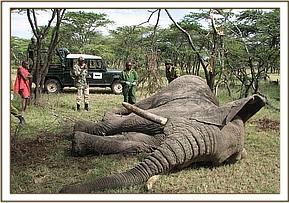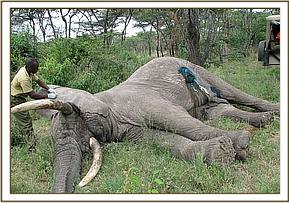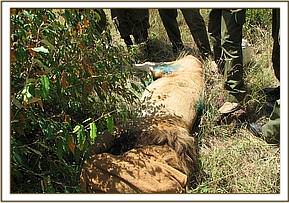Summary During the month of July, 2010, the Central Rift veterinary unit attended to an adult male elephant that had a life threatening wound on the left side of the abdomen in Olkinyei wildlife conservancy, Mara
Summary
During the month of July, 2010, the Central Rift veterinary unit attended to an adult male elephant that had a life threatening wound on the left side of the abdomen in Olkinyei wildlife conservancy, Mara. The treatment was repeated after one week and now the elephant is almost fully recovered.
Other cases attended to included treatment of an injured male lion in Koiyaki-Lemek wildlife Conservancy in Maasai Mara. The lion suffered from several bite wounds on the legs, shoulder and on the abdomen. Two lion cubs of about 3 weeks old were also rescued from Ilbaam area of Talek, their mother could not be found and it was believed that the mother had died or abandoned them. The cubs were air-lifted to Nairobi animal orphanage for tender care. Detailed reports of these cases are highlighted below.
Treatment of an elephant with an injury on the left side of the abdomen in Olkinyei Wildlife Conservancy, Mara.
This was a case of an adult male elephant which had a deep and infected wound on the left lateral side of the abdomen in Olkinyei wildlife conservancy in Mara. The elephant had become very weak, emaciated and rarely moved. The wound was infected, full of maggots and with a lot of pus oozing from it. It was suspected that the elephant had been attacked by an arrow or a spear. It was sighted by the Olkinyei conservancy rangers who then informed the Mara veterinary unit to attend to it.
Chemical immobilization, examination and treatment
The elephant was darted from a vehicle using 18mgs of etorphine Hcl combined with 1500 i.u hyaluronidase, the drug took effect after about 6 minutes and the elephant became recumbent. Unfortunately it was lying on the wounded side and the veterinary team could not access the wound for cleaning, it was not possible to turn it over for wound cleaning because of massive weight and rough terrain. So the elephant was treated using high doses of long-acting oxytetracycline antibiotics, multivitamins and dexamethasone. Blood samples were collected for laboratory analysis and monitoring of infectious diseases including bovine tuberculosis. 

Revival of anaesthesia
The elephant was revived from anaesthesia using 48mgs of diprenorphine hydrochloride administered through the superficial ear-vein. It was to be monitored daily by the Olkinyei wildlife conservancy rangers and the treatment was to be repeated after one week.
Repeat treatment and prognosis
The treatment was repeated after one week, this time round the elephant was sighted at the edge of a small stream just next to where it was earlier treated. Even though the wound had started healing, it still required further veterinary intervention. The elephant was then captured by darting and it went down on a sternal recumbency, it had to be pulled by ropes and supported to lie on the lateral side.
The wound was cleaned using water, 10% hydrogen peroxide and gauze swabs removing all the pus and tissue debris from the infected site, it was also probed carefully using a long forceps to find out if there was any foreign material inside and how deep it penetrated into the abdomen. It was then treated by topical application of tincture of iodine and oxytetracycline spray, then intramuscular administration of long-acting oxytetracycline antibiotics and revived from anaesthesia before it developed numbness on the leg. 




Prognosis
The elephant had good prognosis after the two treatments at an interval of one week, the wound had started showing signs of healing by the time of second treatment. Olkinyei conservancy rangers were advised to monitor it closely and report its progress to the veterinarian just incase it required further attention.
Rescue of two lion cubs from Talek area of Maasai Mara.
Two male lion cubs of about 3 weeks old were found lying under the fence within the cattle boma in Mr. Ole Kamatiah’s homestead in Ilbaam village next to Talek centre just 2 kilometres away from the reserve boundary. The area residents informed the Narok county council officers who later called the Mara veterinary team to come to the rescue of the cubs. It was not known exactly where their mother was but the cubs had stayed in that village for two days, they were already hungry, weak and becoming dehydrated.
Rescue and treatment
The cubs were captured physically by covering them with a blanket and put into the vehicle; they were provided with plenty of clean water to drink, given cow milk to drink using milk teats and kept in a warm room overnight. The following day they were flown by a helicopter to the Nairobi animal orphanage from where they will be taken care of until they grow into adults.
Treatment of an injured male lion in Koiyaki-Lemek Conservancy Maasai Mara
This was a case of an adult male lion in Koiyaki-Lemek wildlife conservancy that was reported to have sustained several severe injuries on the left hind leg, shoulder and abdominal regions. The lion was found lying alone in a thicket at the sides of a small stream within the conservancy. It was in a very painful situation that required an immediate veterinary attention. The wounds were suspected to be bite wounds inflicted by other lions during territorial fights or while fighting for a mate. The veterinary team from Maasai Mara responded on the same day of reporting to treat the lion.
Chemical restrain
The lion was captured by darting using 500mgs of Xylazine Hcl combined with 500mgs of Ketamine Hcl, it was darted on the left thigh and later re-darted using 50mgs of xylazine Hcl combined with 50mgs of ketamine Hcl on the neck muscle, it then took about 10 minutes for the drug to take effect. After it was completely anaesthetized it was blindfolded, covered with twigs and transferred to a cool shade under the thicket from where it was examined and treated.
Physical examination
The lion was still in a good body condition but extremely weak and unable to move or hunt for food. It had sustained severe injuries on the stifle joint of the left hind leg, abdomen, testicles and shoulder, these were bite wounds caused by territorial fights by other lions. These wounds were so painful such that the lion preferred lying down most of the time and not able to hunt effectively and depended on other lions for food. It had some external parasites like ticks and lion flies on the skin.
Treatment
The wounds were properly debrided and cleaned using water and 10% hydrogen peroxide solution; they were also topically treated using a tincture of iodine. It was further treated using antibiotics (Betamox®), multivitamins and dexamethasone through the intramuscular route. Other small bite wounds on the abdomen and shoulder were sprayed by oxytetracycline spray. 



Samples collection
Blood samples were collected in EDTA coated tubes and plain tubes coated with clot retractor, hair samples kept in ethanol solution and ectoparasites such as ticks and lion flies collected and stored in 70% ethanol. These samples were processed and stored in KWS laboratory for further analysis and for health monitoring purposes.
Anaesthesia revival
The lion was revived from anaesthesia after about 1 hour using 25mgs of Atipamezole Hcl administered intramuscularly, it took about 10 minutes for the lion to rise up, it was still weak and was to be monitored by the conservancy rangers who would report its progress to the vet.
Prognosis
The prognosis was good after treatment because the lion had good appetite and was able to feed and take water; it had the risk of developing arthritis which is not easy to treat but after prompt treatment of the wound arthritis is not likely to occur. It was being fed by the other members of the pride which kept visiting it regularly.
Conclusion
The Mara veterinary unit responded effectively to all the reported veterinary cases within Maasai Mara ecosystem. The unit still requires gas refrigerator and a solar panel for processing and storage of biological samples for wildlife diseases research and diagnosis. Kenya Wildlife Service greatly appreciates the support of David Sheldrick Wildlife Trust (DSWT) towards provision of prompt veterinary services to wildlife in Maasai Mara ecosystem, Central Rift region and Ruma National park.
Report by: Dr. Domnic Mijele